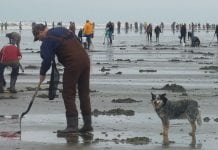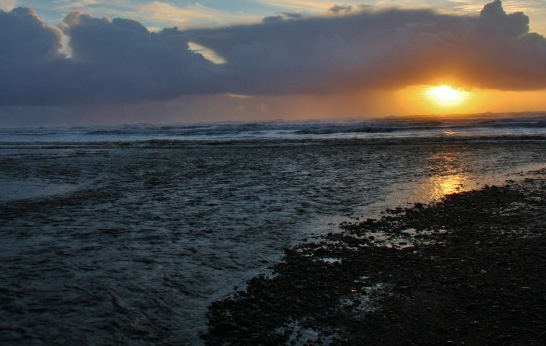By Douglas Scott
 I grew up watching storms on the coast. Once the weather forecast would call for strong winds and huge swells in the Pacific Ocean, my father and I would jump in the family truck and head to the jetty in Ocean Shores or walk along Damon Point in hopes of feeling the sheer power and force of whatever storm would be rolling in. Weeks of my life were spent watching storms in the Harbor, and honestly, they are unlike any other storms in the world. With numerous spots around the Washington Coast, storm watching in the region is world class fun.
I grew up watching storms on the coast. Once the weather forecast would call for strong winds and huge swells in the Pacific Ocean, my father and I would jump in the family truck and head to the jetty in Ocean Shores or walk along Damon Point in hopes of feeling the sheer power and force of whatever storm would be rolling in. Weeks of my life were spent watching storms in the Harbor, and honestly, they are unlike any other storms in the world. With numerous spots around the Washington Coast, storm watching in the region is world class fun.
The storms we get in and around Grays Harbor each year are fantastic, that is, if you enjoy storms. Storms rolling in off the Pacific Ocean can easily have wind gusts up to 60-miles-per-hour and come with six inches of rain each day. The ocean swells can be 15 – 20 feet and are capable of tossing huge logs drifting in the Pacific against the rugged and wild beaches. The strength of the waves can quickly change and erode shorelines, so (obviously) watching storms can be a bit nerve-racking for those new to the activity. While some may scoff at the idea of going out to watch a storm, there are many others who find the experience exhilarating and a quintessential part of living here. Luckily, there are a few rules that you can follow to remain safe and enjoy the unique beauty of a Pacific Northwest storm.
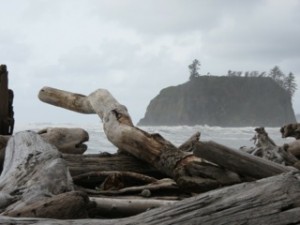
Check the Weather
Obviously, if you go outside during a storm, you’ll want to know what to expect. Knowing the direction and speed of the wind can help decide if a storm is worth watching from a far away location or just close to home. For the best storms, watch for high wind gusts and strong sustained winds. Those storms will usually produce the best waves and the most action. For the best storm forecast information, the National Weather Service provides alerts and warnings for you to monitor. Please know that once the barometer has started increasing, this means a decrease in precipitation, but the increase in barometer usually means a decrease in winds, so plan accordingly.
Read the Tides
The best time to watch a storm is when the tide is coming in and at high tide. Watching a huge storm surge create breakers that get steadily closer helps show the power and force of tidal action. That is why hoping to time an unusually high-tide with the right weather conditions can lead to amazing storm watching experiences. Tide information can be found here.
Dress to Stay Dry
Dressing for storm watching may seem like a silly idea for those wanting to just sit in their car, but to truly experience a storm, one needs to get out in the elements. Standing in the wind and rain and being nearly unable to walk because of wind gusts is an incredible feeling. To be best dressed for storm watching wear as much waterproof clothing as you can. A good pair of waterproof shoes and warm socks is also recommended. Avoid hats and umbrellas, as they will blow away. Also, remember to bring a towel and a change of clothes, as you will want to put on something dry once you are back inside.
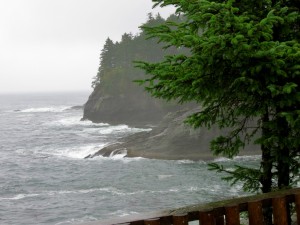
Know Where to Park and Walk
Many sections of the Washington coast allow cars on them, but that is not recommended during storms. Never park on the beach during a storm. Instead, park far above the visible high tide mark and keep an eye on both your vehicle and the water. Many cars – and even a few planes – have been buried by sand or, worse, taken out to sea due to the tide coming in (and storms typically reach higher than those tides). Because of this, parking high on a bluff or close to the main road is advised. While walking near the beach during a storm, stay off of driftwood, away from the water, and preferably on a bluff above the beach. Also, remember to stay out of forested areas during wind storms, as branches can and will fall.
Be Safe
Storm watching can make beaches more dangerous, tossing around driftwood and other debris, as well as sending sneaker waves past where previous waves have been. Staying alert and remaining far from the breakers is advised, as getting too close can lead to a serious accident. Also avoid standing near the edge of bluffs, as erosion may weaken them, or gusts of wind may contribute to a fall. Remember, your actions put search and rescue in danger.
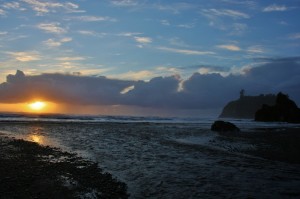
Where to Go
Now that you know the basics of storm watching, it is important to decide where you are going to watch the storm. While any section of beach is good, there are five locations in and around Grays Harbor that give the best experiences for storm watching.
Kalaloch
Kalaloch was voted the best location in Western Washington to storm watch by viewers of King 5 TV in Seattle, and they are right. Not only do the beaches at Kalaloch give you a place to stay and an area on the bluffs to watch the storm, they also provide access to see the waves of the storm surge crash against the sea stacks at Ruby Beach. Watching the storm surge push water up Cedar Creek at Ruby Beach is also quite an amazing thing to witness.
Ocean Shores or Westport Jetty
While there are many sections of the beach that are fun in Ocean Shores and Westport, the best location to storm watch in either town is at the jetty. At the Ocean Shores or Westport jetty, winds will rock your car, rain will fall at a 90 degree angle, and waves will be crashing close to the parking lot spraying the condos and cars with sea foam and salt water. While you may see some people venture out on the rocks during a storm, do not do this, as it is incredibly dangerous.
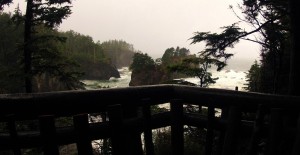
Pacific Beach and Moclips
Often overlooked for the more well-known beaches, storm watching at Pacific Beach and Moclips is a personal favorite. Whether you stand in the wind and rain at Pacific Beach State Park or watch from the pull off at Wreck Creek, north of Moclips, storm watchers will have a great experience.
Cape Flattery
While not located in Grays Harbor, serious storm chasers will find no greater experience than watching a storm from the lookout at the end of the Cape Flattery Trail. As the northwestern-most point in the contiguous United States, Cape Flattery gets rocked by wind, waves and the full force of the relentless waves slamming against the rocky shore. To get to the best vantage point – a wooden lookout on the cliff – there is a short trail though the forest. Be aware the trail can be flooded in places. Dress to stay warm and dry and be ready for a unique and exhilerating experience on the wild Pacific Coast.


























